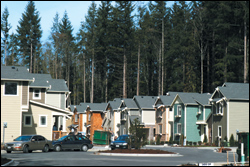Everyone lives in a huge, crass mini-mansion on the Sammamish Plateau with a three-car garage (for the other two family SUVs; the cleaning lady parks down the street). They’re all NIMBY Republicans who couldn’t care less about the environment, and they probably voted for Bush. A bland land of white-bread homogeneity, a soulless suburban cultural desert of false fronts and bad architecture that mask American Beauty-style family dysfunction. That’s the way Seattleites tend to think of the Eastside.
Wrong. Not only are such stereotypes belied by changing demographics (the Eastside is becoming more ethnically and economically diverse even as Seattle’s becoming more uniform), but those former bedroom- suburb communities—from Bellevue to Issaquah, from Kirkland to Redmond—are adapting to these shifts. Not everyone can afford a mini-mansion. Not everyone lives in a nuclear family. Not everyone drives. And the way Eastsiders now live reflects the same pressures that the suburban pioneers of the ’50s and ’60s sought to escape: gridlock, soaring real-estate costs, employers following them across the bridges. Thus the suburb becomes more like the city.
In the following stories, we look at how some Eastsiders are adapting to these trends. Apartments are sprouting by Park & Ride lots. Density and mixed-use planning practices are being incorporated into Redmond Ridge. A Kirkland homeowner opts to renovate, not bulldoze, her frumpy old builder’s spec house. And we send two die-hard Seattle urbanites on an Eastside odyssey to determine if, gasp, they might actually be able to live there. So stop sneering, Seattle, you might soon be making the same trip—in a moving van. Eds.




